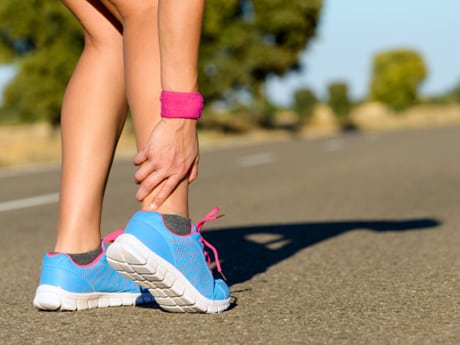Achilles Tendinopathy | Sports Physiotherapy East Fremantle
The Achilles tendon is located behind the ankle joint and connects the heel bones to the calf muscles. It is the longest tendon in the body.
Achilles tendinopathies are overuse injuries which are especially common in joggers and jumpers and other sports that involve the same repetitive running action. Although these injuries can also result from a significant blunt trauma to the tendon itself, it most commonly occurs through overuse/over-training, whereby not enough time has been given for the tendon to recover between training sessions.
The tendon injury pathway has been described in full detail here.
Risk Factors for Achilles Tendinopathy
The risk factors for an Achilles tendinopathy fall into three broad categories:
- Training errors
- Biomechanical factors that increase strain and compression onto the Achilles tendon.
- General health
Training Errors
These include:
- Sudden increases in training activity. For example, moving from sedentary behaviour into a signficant weekly training load.
- Changes in the type of training – e.g. incorporating hill running when all previous activity has been on flat surfaces.
- Increased intensity during training sessions
- Increased length of training
- Increased frequency of training
- Increases in weekly distance – especially applicable with runners.
Biomechanical Factors
- Flat foot posture – increases subtalar joint movement which increases compression of the Achilles tendon against the underlying calcaneum.
- Tight calf muscles – increases the amount of tensile strength being constantly applied to the Achilles tendon throughout the day.
- Poorly supportive footwear. Another common factor can be prolonged time in high-heeled shoes, as this shortens/tightens the calf muscles which then increases compressive and tensile loads through the Achilles tendon when flat footwear is worn.
- Decreased strength through the calf/Achilles tendon, which means that it is unable to cope with the amount of load being applied to it.
- Quadriceps dominance / weakness through the gluteal and hamstring muscles. A quadriceps dominant pattern of movement (e.g. squatting movement) will place more pressure onto the ball of the foot and therefore increase activity in the calf muscles.
General Health Factors
The following factors have a demonstrated correlation with the development of Achilles tendinopathy:
- Obesity
- Diabetes Mellitus
- High cholesterol
Treatment of Achilles Tendinopathy
Simply, management of this condition falls into two categories:
- Load management and symptom control.
- Correction of bio-mechanical abnormalities
Load Management
It is never recommended to completely cease exercise when dealing with a lower limb tendinopathy. Rest is not rehab! And although your symptoms may subside, they will often return immediately once exercise has been resumed. However, we do need to manage our symptoms.
It is important to not allow your symptoms to increase beyond a mild to moderate, or 4/10 pain threshold. This applies during any exercise and also in the 24 hours following exercise, when we will often experience our pain and tightness. If your pain gets above this level, it can be reduced with appropriate rest, ice and anti-inflammatory medications.
Correction of Biomechanical Abnormalities
- If we are finding tightness prevalent throughout the calf muscles (and potentially up the chain into our quadriceps or gluteals, start by addressing this on the foam roller. Note that we recommend using a foam roller as opposed to stretching the calf muscles, as stretching will create further compression of the Achilles tendon on the underlying bone and can thereby worsen your symptoms. Use the foam roller for 2-minutes per body part, 2x/daily. This must be maintained throughout your rehabilitation.
- Wear appropriate footwear for your foot biomechanics. If you have flat feet, you may require a ‘stability’ type shoe which has an inbuilt arch support. Conversely, if you have a high arch, you may require footwear that provides more shock absorption throughout your running cycle.
- Correct your weaknesses. This may involve a graduated strengthening program for your calf muscles and Achilles tendon. But it may also include strengthening of muscles that are ‘not doing enough work’ and thereby overusing the calf muscles – for example the hamstrings or gluteal muscles. This can be easily demonstrated by your physiotherapist!
Prognosis
The prognosis and recovery time of Achilles tendinopathies vary depending on which stage of the injured tendon continuum you are on.
- Reactive Tendinopathy: If you are in the Reactive Tendon Stage, and you have only experienced your pain for days, it often just requires some simple deloading and treatment of compressive factors to resolve your pain within days to weeks.
- Tendon Dysrepair: If your tendon injury has progressed to the tendon dysrepair stage, and you have been experiencing your pain for months, a general rule is that it can take up to as long as you have been experiencing your pain for it to be completely resolved. If this has been the case, we recommend you contact us as soon as possible to start your rehabilitation.
- Degenerative Tendinopathy: This usually only occurs if you have overloaded your tendon, often for years. At this stage there have been irreversible changes to the structure of your tendon. However, although parts of the tendon are irreversibly changed, we can still make changes to the portion of the tendon in the tendon dysrepair stage! This can significantly improve your symptoms with running.
Physiotherapy is highly effective in the management of Achilles Tendinopathy. Book your appointment today at Move Physiotherapy East Fremantle and get yourself on the right track!

